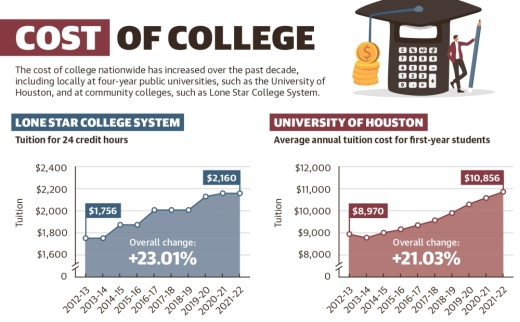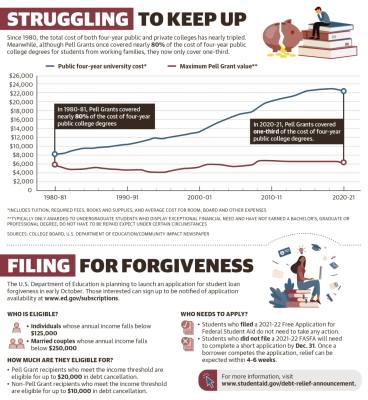Adjusted for inflation, the average annual cost of attending a four-year college full time—including tuition, fees, room and board—in the U.S. has risen from $10,231 in 1980 to $28,775 in the 2019-20 school year, a roughly 180% increase, according to the National Center for Education Statistics.
“We’ve been telling everybody for decades, ‘You have to go to college,’ so the demand has shifted out like crazy, and lots of colleges aren’t functionally much bigger than they used to be, so each spot is more expensive,” said Dietrich Vollrath, a professor and chair of the Department of Economics at the University of Houston.
Federal Reserve System data shows more than 45 million borrowers nationwide have contributed to a cumulative student loan debt of roughly $1.75 trillion with more than $1.6 trillion of those loans issued by the federal government. In Texas, 52% of college graduates in the 2019-20 school year had taken on student loan debt with an average debt of $26,273, according to The Institute for College Access & Success.
In the nine ZIP codes that make up the Spring and Klein area, data shows nearly 193,400 people age 18 and older have some college experience or higher, or roughly 66.7% of the local population age 18 and older.
Locally, the cost of tuition for 24 credit hours at Lone Star College has increased by roughly 23%, between the 2012-13 and 2021-22 school years, while the average annual cost of tuition for first-year students at the University of Houston has increased by approximately 21% within the same time frame.
In hopes of providing relief, President Joe Biden announced Aug. 24 he would issue an executive order that will enable nearly 43 million Americans to have up to $20,000 in federal student loans forgiven.
While the plan has been hailed by borrowers, experts said they fear the loan forgiveness will only lead to further tuition inflation. Betsy Mayotte, president of The Institute of Student Loan Advisors, said while she supports the initiative, she believes it fails to address the root cause of the problem.
“Everybody talks about the student loan crisis, and it exists, but it’s a symptom—not the problem,” Mayotte said. “The problem is the cost of higher education, and this plan does nothing to address that.”
Costly tuition
Vollrath said inflation plays a role in the rising cost of attending college, but he also noted two additional factors that have led to steadily rising tuition rates.
According to Vollrath, rich economies such as the U.S. tend to see faster rates of inflation for services such as education and health care when compared to manufactured goods because the cost of producing those goods diminishes over time.
Vollrath said the second factor contributing to rising tuition costs has been a decrease in financial support from state governments. Between 2008-18, state spending for higher education in Texas dropped from $9,256 per student to $7,107—a 23.3% decrease, according to the Center on Budget and Policy Priorities.
“We’re getting around half the money we thought we might have been getting 20-30 years ago, and you have to account for it, so that ends up getting unloaded on the students usually,” Vollrath said.
During that same time frame, the average cost of tuition at four-year public colleges in Texas increased by $2,302, or 30.4%, CBPP data shows.
“State schools are really like the anchor price of colleges and universities, so if your anchor-price product is going up, it means that the private, more elite schools can raise their prices and still pass the laugh test,” Mayotte said. “But if you lower the cost of your state institutions, that hypothetically would force these private universities to lower [their cost] just to be competitive.”
However, Vollrath said he did not think the blame should be directed solely at declining state contributions to higher education.
“I think there are definitely things you can talk about on the university side,” he said, speaking generally about public colleges. “Why are universities paying for things that seem to drive up tuition that don’t seem to contribute towards the baseline of educating students?”
Plan basics
As outlined in an Aug. 24 news release from the White House, Biden’s three-part plan will provide up to $20,000 in debt cancellation to Pell grant recipients with loans held by the Department of Education and up to $10,000 in debt cancellation to non-Pell Grant recipients.
Individuals will be eligible for this relief if their income is less than $125,000 or $250,000 for married couples. Current students with loans will also be eligible for debt relief, however, borrowers who are dependents will be eligible based on their parents’ income.
“No high-income individual or high-income household—in the top 5% of incomes—will benefit from this action,” the release reads.
Additionally, the White House announced the pause on federal student loan repayments will be extended one final time through Dec. 31 and that borrowers should expect to resume payments in January. Per the release, an application for borrowers to claim relief will be available before the pause on federal student loan repayments ends.
The Department of Education estimated roughly 43 million borrowers will qualify for relief, including 27 million borrowers eligible to receive up to $20,000 in debt cancellation.
“People that owe [$10,000] or less or [$20,000] or less tend to be the ones that struggle the most,” Mayotte said. “The reason their balance is so low to begin with is because of one of two things: either they’ve been paying forever or ... they have debt and no degree.”
The Department of Education is also proposing a new income-driven repayment program as part of the plan, under which monthly payments for undergraduate loans will be capped at 5% of a borrower’s discretionary income—about half of the rate most borrowers currently pay.
The plan also seeks to improve the Public Service Loan Forgiveness program by proposing a rule that borrowers who have served in the military; worked at a nonprofit; or worked in federal, state, tribal or local government receive appropriate credit toward loan forgiveness.
Short-term relief
Across the Lone Star College System—which has campuses in Spring and Klein including LSC-University Park, and LSC-North Harris—the cost per credit hour this fall is $96, up from $88 in the 2021-22 school year. Despite this increase, however, LSCS Chancellor Stephen Head said the college system is still less expensive than a four-year college.
"The average cost to attend a four-year public university is approximately $10,000 based on 30 credits per year,” Head said. “At LSC, the cost is less than $3,000 for those same 30 credits. Over the course of two years, a student could save $14,000 by starting at LSC.”
According to Head, less than 10% of the community college system’s student population borrows loans, but for those who do, the average amount borrowed is $6,000 per year.
“The pro [of the student loan relief plan] is the relief to student loan borrowers. Theoretically, money not spent on loan repayment can be used for other normal expenditures such as cars, houses and typical expenses,” Head said. “The cons include the fact that many who received loans and repaid them believe this decision is not fair.”
U.S. Rep. Dan Crenshaw, R-Houston, echoed concerns cited by Head, adding he did not believe student debt should fall on the backs of taxpayers.
“Eighty-seven percent of people don’t have student loans, [so] you’ve got 87% of people who have either paid off their student loans already or never got one and they work in some blue-collar job and they don’t need a college degree, and now their tax money should go to this?,” Crenshaw said during a Partnership Lake Houston luncheon Sept. 30.
While Head said the student loan relief plan will provide temporary respite, he believes its longevity is short-lived.
“This is a short-term solution,” Head said. “There is still a lot of work that needs to be done for long-term solutions.”
University of Houston officials said their position on the matter stood in line with an Aug. 24 statement from the Association of Public and Land-grant Universities, of which the university is a member.
“For public colleges and universities, which educate more than three-quarters of all students in postsecondary education, addressing long-term state disinvestment is crucial,” the statement reads. “Decades of disinvestment has left students shouldering an increasing share of the cost of college despite vast societal benefits of a college-educated workforce and citizenry.”







